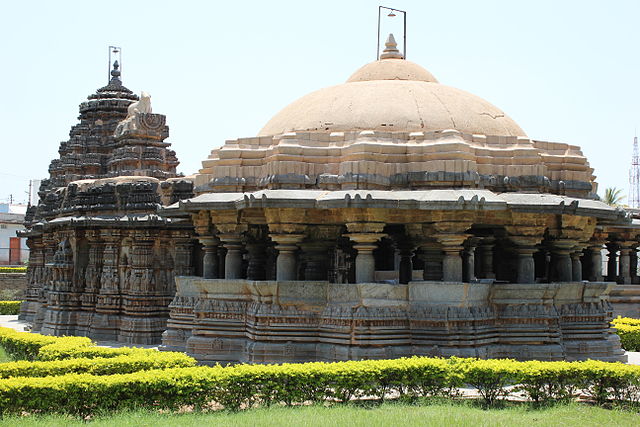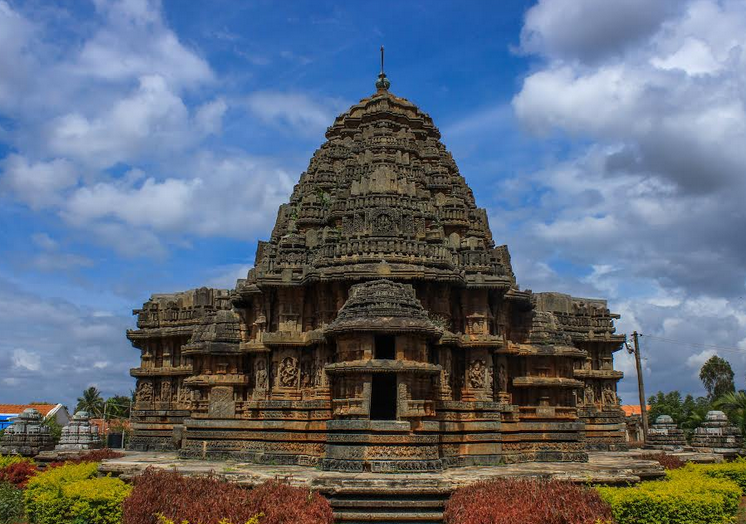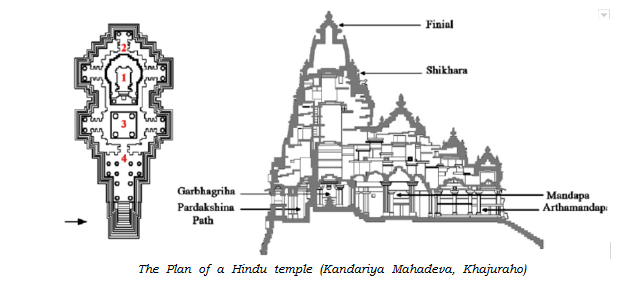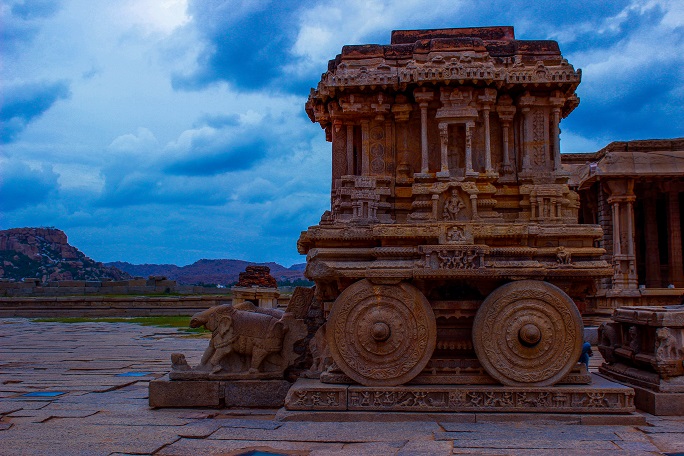The Hindu temple like all other Hindu objects is symbolic, symbolizing the most refined knowledge that the ancient saints of India had codified. In this article, some symbolical aspects of the Hindu temple are discussed.
Temple as a Sacred Mountain
The Hindu temple is built and perceived in the image of Mount Meru, the sacred mountain. Mount Meru represents ultimate knowledge and climbing it symbolizes attaining self-realization.
The Hindu temple is conceived as Mount Meru because, above all, it is a spiritual institution. The Vimana or Shikhara of the temple is constructed to resemble a mountain. It is imagined as the sacred mountain because it facilitates the spiritual journey of man, from being an individual to realizing his oneness with the Supreme Consciousness. The Hindu temple is an agent in this spiritual journey.
European architecture is radically different from the Hindu temple in this aspect and the form of the Church is a testimony to this. The façade is built high and mighty to impress the visitor, however the sanctum is not built in this image and its superstructure is actually quite simple. [1] In the Hindu temple, on the other hand, as the onlooker’s eye is guided from the base of the vimana towards its highest reaches, he does not just realize the loftiness of the architecture, but also comprehends the analogy of the sacred mountain, the mountain which he has to climb in order to attain self-realization, the ultimate goal of all knowledge in Hindu culture and Hindu darshan.
It is due to its essentially spiritual character that the Hindu architecture talks in the idiom of ‘aedicule’. In the context of the Hindu temple, the term aedicule refers to the miniature shrine or a mini replica of the entire temple, temple shikhara or vimana, which is to be found most prominently on its shikhara and outer walls of the garbha-griha. It is found in all three major varieties of Nagara, Vesara and Dravida and is so profusely used in some architectural styles such as that of the Kalyani Chalukyas and Hoysalas of Karnataka that Gerard Foekema calls the very style as ‘architecture decorated by architecture’.
The aedicule is so universally present that it overwhelms the visitor, forcing him to constantly keep shifting his attention from one miniature shrine to another, making it hard for him to distinguish where one aedicule ends and another begins. It is this feature which led James Fergusson to observe that “everywhere…in India, architectural decoration is made up of small models of large buildings.” [2]
Adam Hardy who considers the idiom of aedicule as the fundamental concept behind Indian architectural thinking, says:
“…it was some time after my first trip to India that it gradually became clear to me that aedicules are not just ornaments, but the basic units from which most Indian temple architecture is composed. A temple design is conceived as containing numerous smaller temples or shrines, arranged hierarchically at various scales, embedded within the whole or within one another. Once this simple concept is understood, other things fall into place.” [3]
The Hindu philosophy imagines macrocosm in microcosm (Yatha pinde, tatha brahmande;) and this thinking is reflected in all art-forms in India. It is also the basic idea behind the idiom of the aedicule. The entire temple is reflected in its parts. Sometimes the aedicules are themselves made up of smaller aedicules and this series continues up to the point where architecture allows it to. It conveys the idea of an endlessly regressing series of aedicules, something like the fractal geometry.
As the temple is a representation of the universe, hence the entire universe is reflected again and again in the smallest parts of the temple. The idiom of aedicule is most prominently used in the shikhara of the temple. In some styles, like the Shekhari mode of the Nagara style, the shikhara is made of its smaller versions, called urushringas (half shikharas). These urushringas crowd together and rise to meet at the top beneath the amalaka.
Coming back to the temple as a sacred mountain, this imagery is replicated in its horizontal profile too.
As the Hindu temple evolved, it started developing many constituent parts, other than the garbha-griha. Just before the garbha-griha is the antarala, where the priests officiate and mediate between the god and the devotee. After it, comes mandapam, where the devotees gather and have darshan of the deity. Over centuries, the mandapam proliferated from one to many: mahamandapam, mandapam, ardh mandapam and mukh mandapam.
Each one of these components of the Hindu temple has a vimana counterpart, which can be seen from the outside and which also functions as their roof. These vimanas or roofs of these constituent parts of temple ascend in an increasing order from mukh mandapam, to mandapam, to mahamandapam, and then finally to garbha-griha. The antarala has a shukanasika as its roof or the outer component and it is built as a nose protruding out from the shikhara or vimana of the garbha-griha and is generally higher than the roof of the mahamandapam.
As a devotee enters a Hindu temple, such as the Kandariya Mahadev temple of Khajuraho, and as he proceeds through the various parts of the temple, from mukh mandapam, to mandapam, to mahamandapam, and then finally to garbha-griha, he symbolically climbs the Mount Meru, leaving the world, its multiplicity and ignorance behind and proceeds towards the pinnacle of knowledge, that is self-realization; he proceeds to have darshan of the deity in the garbha-griha, where he realizes his oneness with the deity or the Supreme consciousness.
This symbolism of the devotee’s journey from the outer world to the inner world is heightened by the decorative sculpture or the absence of it in various parts of the temple. The outermost walls of the mandapam and the adhisthana is where the scenes from the world are described in which the devotee sees every kind of activity that takes places in this world; from war to sex.
As he proceeds inwards he witnesses scenes that are less worldly and have a sacred flavor to it; like gandharvas playing divine instruments or apsaras playing in divine gardens and minor deities in different poses; as he proceeds further inwards, he sees major attendant deities like Surya, Varuna, Agni etc. and other sages along with the different forms of the primary deity.
As he proceeds further inside, only deities like Shiva, Vishnu, Ganapati and Shakti are to be seen along with their consorts and in the garbha-griha there is no other murti, deity, or decoration, other than the principal deity. The temple thus is a representation of the entire cosmos, reflecting everything that takes place in this world.
This symbolism is replicated in the play of light and darkness in various parts of the temple. The outer walls and the adhisthana are naturally fully in the light and as the devotee proceeds inwards from the scenes of the outer world to the scenes of the inner sacred world, the light decreases and in the garbha-griha, it is almost non-existent, where the world completely disappears and there is only the Supreme Consciousness and the oneness of the devotee with his deity. Here there is no light of the world, good or bad, just the deep calm that is characteristic of Brahma (not Brahmaa of the Hindu Trimurti), the Supreme Consciousness, which is without any attributes. [4]
The Garbha-griha as the Sacred Womb
The Garbha-griha is the most important part of the temple. This is where the deity resides. Its importance cannot be overstressed, architecturally or spiritually. [5]
The garbha-griha is so named because it is literally the womb of the temple. It is the geometrical centre of the temple site, with its centre, the brahmasthana, occupied by the primary deity. It is called the womb, because under the deity, the ‘seed’ of the temple is inseminated in a kalasha (pitcher) and buried. It is directly above this that the image of the deity is installed.
Some shastras instruct that this pitcher is buried beneath the doorjamb of the garbha-griha. This kalasha contains the ‘seed’, the supreme potentiality, from which the whole world emerges. The kalasha contains hidden components as Rao explains:
“The kalash has an important hidden component, viz. ‘the golden person (suvarna purusha)’, who is regarded as the very soul of the temple. The belly of the kalash is made to contain a tiny cot made in silver, copper or sandal-wood, over which is laid on a soft-feather mattress the golden icon of this ‘person’, with one hand holding a lotus flower over the heart and the other carrying a triple-flag. Four little pots made in gold, silver or copper, and containing consecrated water are placed on the four sides of the cot. Near the recumbent ‘person’ is kept a golden or silver pot filled with ghee.” [6]
The symbolism of temple reflecting the entire cosmos is also contained within the kalasha. It contains all the precious elements or metals that constitute the world. In this way, it represents the cosmos in the seed form. The garbha-griha symbolizes the Supreme Consciousness, which is the origin of the universe. The ritual of putting the ‘seed’ or the kalasha under the garbha-griha is called as Garbhadhana, ‘the insemination process’:
“The seed is deposited at night in the womb of mother Earth, as Garbha, Germ of the temple, close to the door jamb of the Garbhgrha. In the vertical, in the upward direction, which is that of growth, from below, along the jamb of the door and above it, the power of germination lifts as it were the lid of the Garbhagrha, and transcends the flat ceiling of the Garbhagrha, step by step, level by level in ever diminishing tiers to the top of the superstructure; there once again it rests and is level as the Skandha (shoulder course) before it attains its crown and is surmounted by the finial.” [7]
The Temple as the Divine Tree
The symbolism of the seed is taken further. This seed is believed to have sprouted upwards in the form of the temple vimana and branching out in various shoots, leaves and branches, it again coalesces at the top in one kalash, bearing fruit which again contains the seed from which it came, and thus directly above this, outside the temple, over the vimana, another kalash is installed which has the same ‘seed’, which is deposited in the kalash underground.
Here the temple vimana is imagined as a tree. From the seed underground, it sprouts as an upright tree and it merges with the branches of another tree, which is upside down. The branches of both the trees meet in the middle of the vimana. At the top of the vimana is the ‘seed’ of the inverted tree. As S. K. Ramachandra Rao puts it:
“The spot where the ‘womb’ is hidden would be the seat of the icon. The icon represents the sap of the temple-tree, the four walls would indicate the spreading branches all around. The roof resting over the wall is technically called ‘row of doves’ (kapota-pali or simply kapota), after the birds that perch on tree-tops. The sanctum is thus a neat model of the growing tree.” [8]
The seed in the underground holds the seed of supreme consciousness. When this consciousness sprouts, it takes the form of the deity in the garbha-griha. On the other hand, the consciousness from above also descends and meets the consciousness that is rising from below. The ascent of individual consciousness is complemented by the descent of the universal consciousness.
It is a symbolic way of showing the individual consciousness rising up to meet the universal or supreme consciousness. It symbolizes the essence of all Hindu knowledge, that of self-realization, the state of oneness of the devotee with the supreme consciousness. S. K. Ramachandra Rao, commenting upon the ascent and descent of consciousness, says:
“Under the ground it is in a dormant, nebulous condition, and in the sanctum it gets transformed into a world of materiality and activity. In the tower it rises above this world, before it is absorbed in the universal consciousness at the summit of the finial… Man’s approach is one of ascent of matter towards the spirit. But it becomes meaningful only if there is a complementary process of descent; the divine spirit must flow down into the material. The finial of the tower symbolizes the dual act of gathering the divine essence from the formless cosmos and communicating it to the main mass of the tower. The essence here acquires a concrete form and then descends into the sanctum, to be focused in the icon.” [9]
This ascent and descent are taking on the vertical axis of the temple, in the garbha-griha and in the vimana that tops it. The devotee that stands in the mandapam, in front of the deity lies on the horizontal axis of the temple. It is his active desire, his deep faith, which lets him partake in the divine ascent and divine descent that is taking place in the garbha-griha.
Through the authority of the shastras; the agency of the temple as a Yantra to bring about desired goals; through the worship offered by the priest on the behalf of the devotee; and through divine grace, the devotee partakes in the ascent of consciousness. Deeply meditated upon, the ascent of the consciousness in the garbha-griha becomes his own ascent.
“The shrine thus demonstrates the constellation of the human and the divine currents; matter moves up and the spirit flows down. The devotee that stands in front of the icon is expected to partake of this transaction. The emanations that proceed from the icon must be picked up by the faith in his heart. Devotion is the transformer. The rituals conducted within the shrine involve these ideas, and attempt to facilitate transformation along the horizontal axis of icon-devotee. The devotee represents active matter and the icon passive spirit. The two are brought together in the creative act of worship.” [10]
This is why darshan holds such importance for a Hindu devotee visiting a temple. More than prayers, more than signing devotional hymns, it is the act of darshan, which is central to a temple visit and which transforms the individual consciousness of the devotee having darshan to higher levels.
The symbolism of the temple vimana as tree is also understood by its etymology. The very Sanskrit word ‘vimana’ has two connotations: “that which is without comparison” and “that which brings about fruit”.
The Temple as the Sacrificial Fire
The temple vimana is also imagined as the fire of a fire altar, of a Yajna vedi. The shape of the vimana, which tapers, recedes and coalesces into one point at the top with many of half-vimanas, or half-shikharas or miniature aedicular vimanas decorating the ascent of the vimana resembles the sacrificial fire of a fire altar. [11]
The Hindu temple is, in fact, an evolution of the Vedic fire altar, the Yajna Vedi, in which the Yajnas were performed. Stella Kramrisch says:
“The Sulva-sutras contained in the Kalpa-sutras, represent the rules and give proportionate measurement for laying out and piling up the Vedic altar. On them basically rests the building of the Hindu temple.” [12]
The priests who performed the Yajnas, invoked the deity through mantras and imagined his personified form in the Yajna fire. However, as the Vedic Yajna could only be performed by priests trained in the art of Vedic chanting of mantras, not everyone was able to take part in the process.
The temple was the solution to this problem. The deity who was invoked and imagined in the Vedic fire took a permanent form in the temple in the form the temple deity and the entire temple structure was imagined as the Yajna Vedi. A temple priest was appointed who maintained the ritual cleanliness, necessary to maintain the divine presence. And he would offer worship on behalf of the devotee and thus anyone who wished, could participate in the divine process.
As the Hindu Shastras see it, the temple, as a concrete structure took form when spirituality in general population decreased; people stopped seeing the divine and the sacred in everything and need was felt to create a permanent structure in which a temple priest could officiate the sacred process. Thus, the Hindu temple took its present concrete form. But it should not be forgotten, that both the essence and the form of the Hindu temple is derived from the Vedas and the Vedic fire altar, one way or the other.
To a Hindu, sankalpa (resolution) is of primary importance. It is believed that this universe is the result of the sankalpa of Brahma, or Shiva or the Supreme Consciousness. The symbolism of the temple, through its rituals, strengthens this resolve of the devotee, the resolve of seeking self-knowledge. All symbolism of the Hindu temple is geared towards this objective, the ultimate and final goal of anything Hindu or Sanatana, if you prefer.
NOTES AND REFERENCES
- Kramrisch, Stella. The Hindu Temple. Vol. I. New Delhi: Motilal Banarsidas, 1946. (2015 ed.). p. 161-162.
- Fergusson, James. A History of Indian and Eastern Architecture. London: John Murray, 1876, p. 285.
- Hardy, Adam. The Temple Architecture of India. Chicester: John Wiley & Sons, 2007. p. 10.
- Kramrisch, Stella. The Hindu Temple. Vol. I. New Delhi: Motilal Banarsidas, 1946. (2015 ed.). p. 162.
- Ibid. p. 163.
- Ramachandra Rao, S. K. The Vastu-Silpa-Kosha: Encyclopaedia of Hindu Temple Architecture and Vastu. New Delhi: Divine Books, 2012. Vol. I. p. 78.
- Kramrisch, Stella. The Hindu Temple. Vol. I. New Delhi: Motilal Banarsidas, 1946. (2015 ed.). p. 165.
- Ramachandra Rao, S. K. The Vastu-Silpa-Kosha: Encyclopaedia of Hindu Temple Architecture and Vastu. New Delhi: Divine Books, 2012. Vol. I. p. 74.
- Ibid. p. 79.
- Ibid. p. 80.
- Ibid. p. 74.
- Kramrisch, Stella. The Hindu Temple. Vol. I. New Delhi: Motilal Banarsidas, 1946. (2015 ed.). p. 11.
Disclaimer: The facts and opinions expressed within this article are the personal opinions of the author. IndiaFacts does not assume any responsibility or liability for the accuracy, completeness,suitability,or validity of any information in this article.
Pankaj Saxena is a scholar of History, Hindu Architecture and Literature. He has visited more than 400 sites of ancient Hindu temples and photographed the evidence. He has been writing articles, research papers and reviews in various print and online newspapers and magazines. He currently works as the Asst. Professor, Centre for Indic Studies, Indus University, Ahmedabad. He has authored three books so far. He maintains a blog at http://literaryfalcon.wordpress.com/





